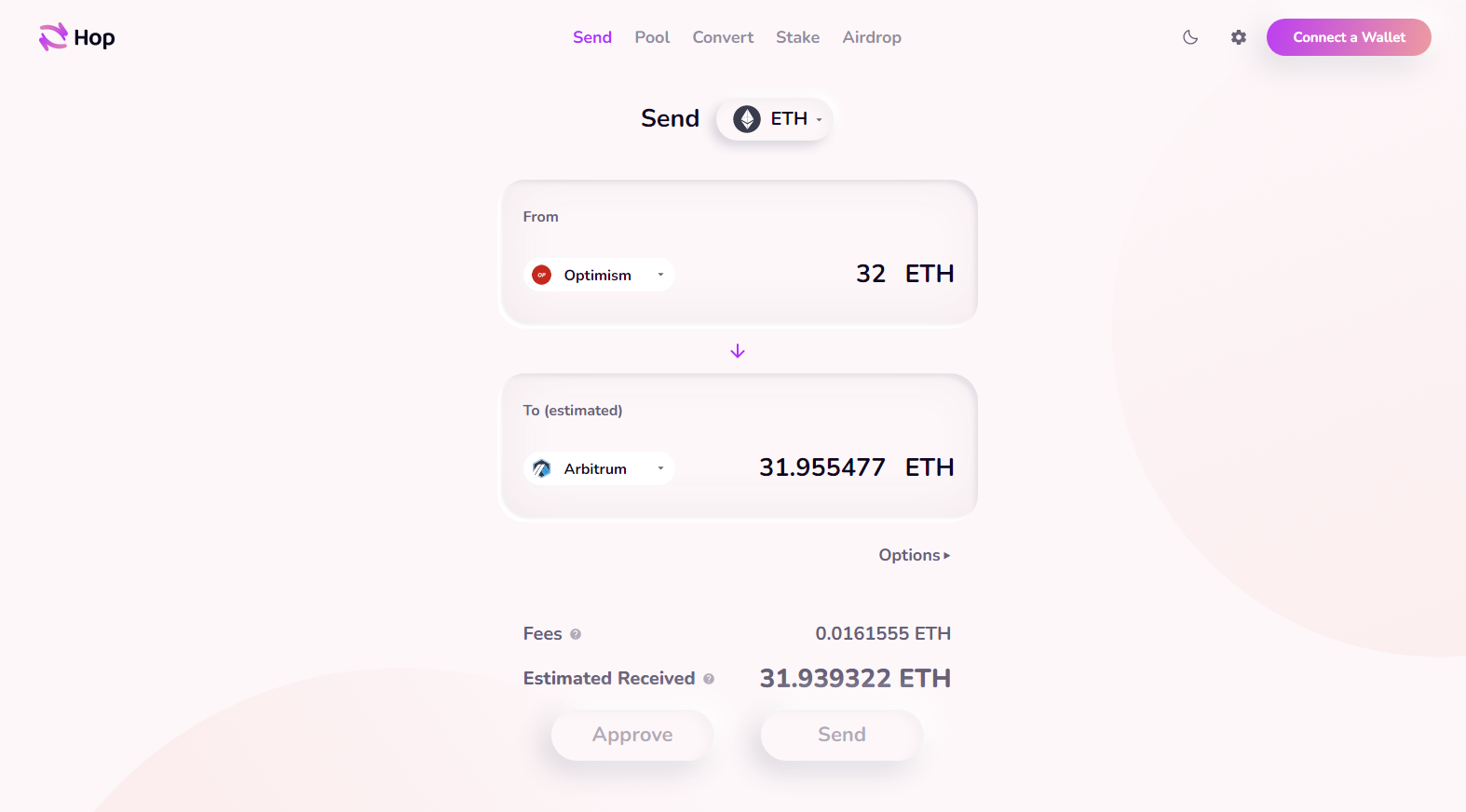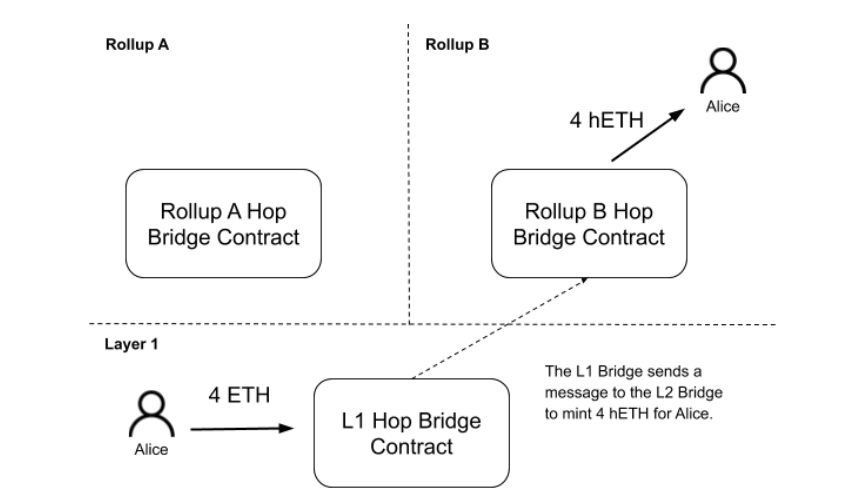The Ethereum network currently has numerous scaling solutions, each with their own governance tokens. These varied solutions have also made transferring tokens from layer 1 to layer 2 slightly problematic.
That’s where Hop Protocol comes in. The protocol provides a mechanism to exchange tokens between Ethereum scaling solutions. In this guide, you’ll learn everything you need to know about Hop Protocol, including how it works, and its unique features.
In this guide:
What is Hop Protocol?

Hop protocol is a mechanism for transferring tokens over a shared layer 1 network quickly and without trust. It provides customers with a two-pronged token bridge for Ethereum’s layer 2 network. The solution aims to facilitate the rapid movement of a token between layer 2 and a scaling solution’s governance token.
Hop Protocol also aims to construct a unique community-oriented decentralized autonomous organization (DAO), which seeks to enhance layer 2 scalability.
How does Hop Protocol work?
Hop protocol operates effectively by leveraging Bonders, who, by providing liquidity, earn a fee. Technically, a user will send any amount of token to Bonders on the source chain, which is where the asset is being sent from. After that process, the Bonder will send the asset to the user’s counterpart on the destination chain.
Hop protocol plays a significant part in the transaction by ensuring that the Bonders have sent the tokens. No user will be happy if they send their token to Bonders, but they cannot reach the destination blockchain. Furthermore, the system employs a particular type of token called hTokens. These tokens also act as a technique to ensure that all transactions are accurately recorded.
hTokens can traverse several chains, such as Ethereum to L2 protocols, and vice versa. It is important to highlight that moving tokens from one location to another can take longer than expected, which might be inconvenient for users. Therefore, Bonders will provide liquidity up front for customers so that they can simultaneously have their tokens as they wait for the network to complete the transfer of hTokens. Additionally, you can think of hTokens as a shadow token that follows the genuine token.
What makes Hop Protocol unique?

Below are some unique features of Hop Protocol that enable users to bridge ERC-20 tokens generically.
Sponsored Sponsored- Hop Protocol provides a scalable roll-up to roll-up general token bridge. This works through Automated Market Makers (AMMs) to swap each bridge token and its corresponding canonical token among each roll-up to have dynamically priced liquidity and incentivize liquidity rebalancing of liquidity across the entire network.
- Hop employs the same level of protection as an underlying roll-up. Meaning, users can never lose or have their assets stolen. However, it is essential to note that the worst-case situation is the Bonders going offline. Even so, the users will only experience a delay equivalent to the roll-up’s exit time.
- Hop has a two-pronged strategy to generate cross-network tokens, and by utilizing AMMs, it can conduct transactions very first and efficiently.
- Connectivity is on the horizon since it supports a vast array of destination chains. Consequently, it provides excellent connectivity. This is, however, restricted to the Ethereum mainnet and layer 2s.
- In terms of statefulness, Hop has some limitations in its capacity to transfer specific assets, as it now only supports five different types of assets.
What are hTokens?
hTokens are cross-network bridge tokens that users can transfer in batches from roll-up to roll-up and are then claimed on layer 2 for the underlying asset. They also act as intermediary assets within the Hop protocol. This is a bridge that permits even trustless swaps. Moreover, end-users are not interacting directly with hTokens; instead, they interact with the appropriate rollup’s canonical token. Each Hop bridge coin represents a layer 2 deposit in the Hope Bridge layer 2 contract.
If you invest 4 ETH into the layer 2 Hope Bridge Contract, you can mint 4 Hop ETH from the layer 2 Hop Bridge Contract. Users can redeem Hop Bridge tokens for their underlying assets on layer 2, which then causes the Hop Bridge Token to be redeemed on layer 2 to be burned. Therefore, a Hop Bridge token transferred from one roll-up to another is burned and minted on the destination roll-up.
Canonical tokens: what are they?

The term “canonical token” describes a layer 1 token that is bridged within the layer 2 protocol. For instance, the layer 2 DAI token would be the canonical token of layer 1 DAI token. Using the official token bridge for layer 2, users may transmit and receive layer 1 tokens and layer 2 token representations of even the layer 1 token.
Also, it may provide users with the option to convert to the current layer 2 token representation. Even if many layer 2 token representations exist for a layer 1, an application will often lean towards the single layer 1 token representation. It is in a program’s best interest to be compatible with other apps on the roll-up.
SponsoredThe canonical model of the roll-up (canonical ETH/ canonical DAI) is the most widely acknowledged variant. In the majority of circumstances, however, canonical tokens are created using a native token bridge unless an application token bridge exists. In this circumstance, the version generated via the application bridge will be chosen.
What is HOP token?

To fully understand Hop Protocol, it is necessary to understand how layer 2 solutions work. These solutions exist on top of a blockchain’s mainnet, or layer 1, and uses different technologies to boost transaction throughput and reduce transaction costs. It preserves the security of the layer 1 chain while enabling the processing of additional transactions.
When you are using the Hop Protocol to transfer tokens, new tokens called hTokens are produced. These tokens indicate your position (hETH, hDAI, etc.) and may be transferred across chains at a cheap cost. Then, these hTokens are exchanged into tokens on the appropriate chain and handed to the sender. This exchanging technique of tokens avoids transmitting tokens directly and depends on proxy tokens to decrease expenses. The protocol also enables token pooling and staking of several layer 2 solutions, enabling users to receive rewards without transferring tokens to the mainnet.
HOP tokenomics
HOP token is the blockchain’s governance token. It gives users the power to vote according to each token they own. They may use these votes to weigh in on ideas like which tokens can be traded, the addition of layer 2s, and the administration of the treasury money.
The current Hop Exchange price is $0.10. The maximum supply is 1 billion HOP coins, and the distribution of tokens is as follows:
Sponsored Sponsored- 60.5% is in the Treasury
- 22.45% of the budget to the team
- 8% for airdrops
- 6.25% for shareholders
- 2.8% for the next squad
How to buy HOP tokens
HOP is available on a decentralized exchange (DEX) such as SushiSwap or Uniswap as well as on centralized:
The universe of exceptional Hop-ability
Hop Protocol is working on a critical problem within the Ethereum scaling solution niche. It can streamline the use of these scaling solutions, which could enhance the experience of users. There are some interesting ideas it is working on, though time will tell if it is executed properly.
HOP remains a project worth keeping an eye on. The unique features could benefit the industry as a whole, as Ethereum scaling is a big part of the DeFi market.
Still not sure about how Hop Protocol works? Do you want more information on the general pain points it is working on? Check out the BeInCrypto Telegram group, where members will happily answer all your questions.

